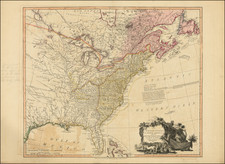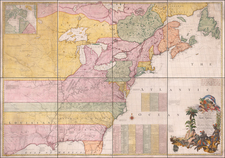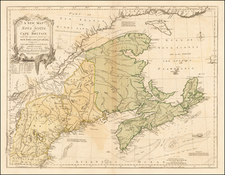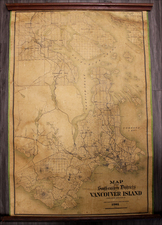An exceedingly rare and artistically virtuous compostion embracing a map of Cape Breton Island and the Great Lakes, by the Venetian master Coronelli.
This rare and elaborate compostion contains two maps, framed in a finely engraved border of a Baroque architectural design. The map in the upper portion depicts Cape Breton Island, in the Canadian Maritimes, then a part of the French colony of Acadia. The southern coast features several place names, some of which survive today, including: Baye Sapagnole, Scattari Is, Petit Barachoua, Canceau and more. The map was printed before the construction of the great fortress of Louisbourg (commenced 1719). It is derived from Coronelli's Isola de Capo Breton (Venice, 1695), the first separately-issued map of Cape Breton.
The map below, entitled 'Louisiana Parte Setteno Descritta...' features the era's most important depiction of the Great Lakes and the upper Mississippi Basin. Coronelli drew on his privileged access to information from the reports of Jesuit Missionaries who had pioneered exploration in the region in the 17th Century. French expeditions included the voyages of La Salle, Hennepin, Marquette and Jolliet, amongst others. Several forts, Indian villages, and missionary stations are labelled. The 'R. De Chekagou' roughly corresponds to the modern location of Chicago. Also visible is the the Ottawa River route into Georgian Bay, the preferred route from Montreal to the west. The mapping of Lake Superior is impressive, as both the Keweenaw Peninsula (P. Kioanan) and Isle Royale (I. Miniong) are located. The present map is based on Coronelli's La Louisiana, Parte Settentrionalle, Scoperta sotto la Protettione di Luigi XIV (Venice, 1695), which is in turn based on Coronelli and Jean-Baptiste Nolin's Partie Occidentale du Canada ou de la Nouvelle France…" (Paris, 1688).
The piece is dedicated to Francesco Farnese (1678-1727), the Duke of Parma & Piacenza, and a prominent patron of Coronelli.
Vincenzo Maria Coronelli (1650-1715) apprenticed as a xylographer, before joining the Franciscan Order in 1665. After studying astronomy, philosophy and mathematics, in 1678, he was commissioned to make a set of terrestrial and celestial globes for Ranuccio II Farnese, the Duke of Parma, that were 5 feet in diameter. From 1681 to 1683, Coronelli was summoned to Paris by the 'Sun King' Louis XIV. There he constructed the legendary 'Marly Globes'. At over 10 feet in diameter and nearly 4,000 pounds in weight, they were the grandest globes ever constructed and today reside at the Bibliothèque nationale in Paris.
The fame and importance of the Marly Globes led Coronelli, who had since returned to Venice, to produce a 42 inch diameter globe in 1688, of which complete examples reside in a number of major institutional collections around the world. Separate globe gore sheets from this famous globe periodically appear on the market. During this period Coronelli published his Atlante Veneto and founded the 'Accademia Cosmografica degli Argonauti', the world's first geographical society.
The present map sheet is exceedingly rare, we have not been able to locate another example.
Vincenzo Maria Coronelli (1650-1718) was one of the most influential Italian mapmakers and was known especially for his globes and atlases. The son of a tailor, Vincenzo was apprenticed to a xylographer (a wood block engraver) at a young age. At fifteen he became a novice in a Franciscan monastery. At sixteen he published his first book, the first of 140 publications he would write in his lifetime. The order recognized his intellectual ability and saw him educated in Venice and Rome. He earned a doctorate in theology, but also studied astronomy. By the late 1670s, he was working on geography and was commissioned to create a set of globes for the Duke of Parma. These globes were five feet in diameter. The Parma globes led to Coronelli being named theologian to the Duke and receiving a bigger commission, this one from Louis XIV of France. Coronelli moved to Paris for two years to construct the King’s huge globes, which are 12.5 feet in diameter and weigh 2 tons.
The globes for the French King led to a craze for Coronelli’s work and he traveled Europe making globes for the ultra-elite. By 1705, he had returned to Venice. There, he founded the first geographical society, the Accademia Cosmografica degli Argonauti and was named Cosmographer of the Republic of Venice. He died in 1718.









![[ Canada / New France Official Report Regarding Return of Fort Bourbon and Dispute with Hudson Bay Company ] May 27, 1699 Report of Louis II Phélypeaux, Comte de Pontchartrain](https://storage.googleapis.com/raremaps/img/small/100562.jpg)

![[First Map of the Mississippi River] Carte de la decouverte faite l'an dans l'Amerique Septentrionale](https://storage.googleapis.com/raremaps/img/small/93571.jpg)


